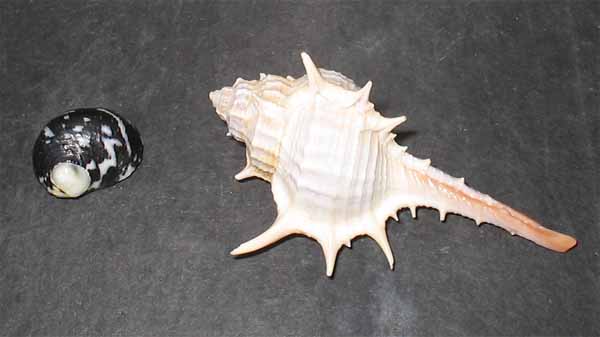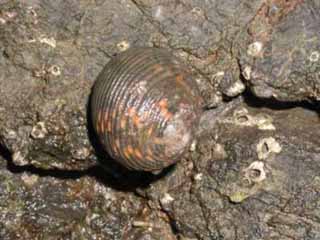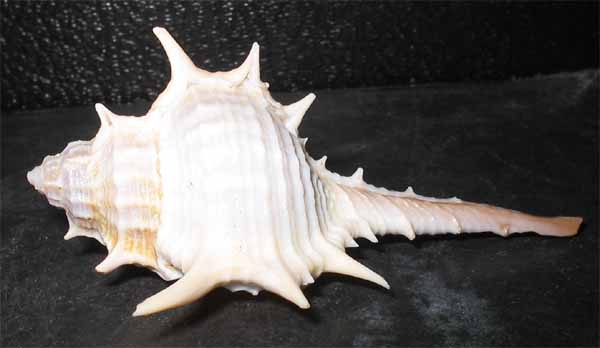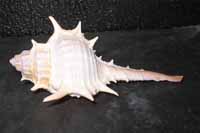C. STRUCTURAL ADAPTATION
SHELL GEOMETRY IN SNAILS:
An adaptation is a character of an organism that performs a specific function. Adaptations can be structural (e.g.. bird wing), behavior (e.g. migration), or biochemical (e.g. photosynthesis). Adaptations are often imagined as examples of perfect design, so much so that some adaptations are sometimes invoked as proof of divine intervention in the organic world. While the effectiveness of many adaptations is apparent, the notion of perfection in adaptation has been seriously misunderstood by many. Organisms actually possess characters that enable them to cope with their environment – but nothing more. It is adequacy of design that characterizes organisms, not perfection of design.

In this exercise we are interested in investigating the adaptive significance of shell form among marine snails. Our goal in this exercise is to understand structural adaptation in terms of the engineering problem that a lineage (i.e., an evolving group of organisms) must overcome. In analyzing these correlations remember that all snails have a muscular foot (see Figure below) which they use for locomotion and attachment to the substrates upon which, or in which, they live. The shell is a coiled, hollow tube into which the animal can withdraw for protection.


C1. ADAPTATION IN SNAIL SHELLS: Although virtually all snail shells are coiled, shell shape nevertheless varies widely among snails. This variation appears to be related to the needs of the lifestyles adopted by individual species. We will look at two species of tropical marine snails, and evaluate the shape of their shells in terms of the environments in which they live. Our goal will be to discover the functional significance of some attributes of shell form in these species.


C1.1 Surface Crawlers: Many species of snails live in shallow tropical lagoons, and other reef locales, protected from strong waves. Many of these species could be called “surface crawlers” because they crawl slowly across the surface of loose, sandy substrates that are common in such environments. These snails live exposed to the attacks of large predators, such as starfish, which try to turn them over to get at the soft tissues underneath, and fish, which try to swallow them whole. Thus, to survive, these snails must develop defenses against such attacks.

C1.2 Graspers: Many other snail species living in reef locales do so by fastening themselves securely to hard rock surfaces on wave swept shorelines and on reefs that are exposed to the surge of waves and tides. They scrape algae off rocks as food. In such harsh environments predators are not much of a problem. Instead, such snails must contend with the problem of dislodgement by strong waves from the rocks to which they must cling for survival. For this reason, such snails are often referred to as "graspers" because they fasten themselves tightly to rocks by grasping the rock surface with their strong, muscular foot.

All of the specimens were collected on the reefs at the eastern end of the island of St. Croix, U.S. Virgin Islands.
| LIFE STYLE | SPECIES |
ENVIRONMENT | SPECIMEN |
Grasper |
Nerita tessellata |
Exposed Rocks
|
 |
Surface Crawler |
Murex beaui |
Loose Sand |
 |
TABLE 3.1: Grasping and surface crawling snails studied in this exercise.
C2. ANALYSIS OF SHELL FORM: In our examination of shell adaptation we shall focus on two attributes of shell form: 1) aperture size; and 2) spines.
C2.1 Aperture Size: The aperture of a snail shell is the large opening in the shell which leads to the shell interior. In life, the animal’s foot extends outward through the aperture and rests against the flat, smooth, shiny region on the underside of the shell, referred to as the apertural lip. Not all snails have an apertural lip. The size of the aperture plus apertural lip, where present, is an index of the size of the animal’s foot. Examine the apertural region in each specimen. Determine the size of the aperture and apertural lip, if present, relative to the size of the shell in both Nerita and Murex. To do this, we will define aperture area as given in Figure 3.5, and we shall express shell size in terms of shell area, which is also defined in Figure 3.5.
Measure aperture length (A, in Figure 3.5), aperture width (B), shell length (C), and shell width (D) for Nerita and Murex, and record your results in the appropriate spaces in Table 3.2. Note that for Nerita, aperture length is based on the distance between the outer lips of the aperture rather than between the inner edges. Calculate aperture area, shell area, and relative aperture area according to the formulae defined in Figure 3.5, and record the results of your calculations in Table 3.2.

FIGURE 3.5. Definition of geometric parameters for snail shells.
TABLE 3.2: Morphometric data for grasping and crawling snails.
Species |
A |
B |
C |
D |
Aperture Area |
Shell Area |
Relative Aperture Area |
Nerita tessellata
|
|
|
|
|
|
|
|
Murex beaui
|
|
|
|
|
|
|
|
C2.1.1 Which of the two species has the largest aperture relative to the size of the shell? What is its life style?
C2.1.2. Considering that aperture size is an index of foot size, what adaptive advantage does a large aperture convey to grasping snails? Of what value might this be to snails living on wave-swept rocks?
C2.2 Spines: Murex, and other surface crawling snails, live on loose, sandy substrates which provide no firm attachment for the animals. As a result, they cannot rely on strength of attachment to prevent being overturned or grabbed by predators. Structures other than those associated with the foot must act in this defensive role. Examine the picture of the Murex shell, can you tell what these defensive structures might be?
C2.2.1. Which shell, Murex or Nerita, have the largest area to support themselves?
C2.2.2. Would the shells be harder or easier to roll or overturn if they had no spines?
C2.2.3. Would they be harder or easier to swallow without spines?
C2.2.4. Based on these observations, what do you think is the function of the spines in Murex?
Click here to go back to the main page
©J.A. Chamberlain, Jr. - Brooklyn College - Earth and Environmental Sciences